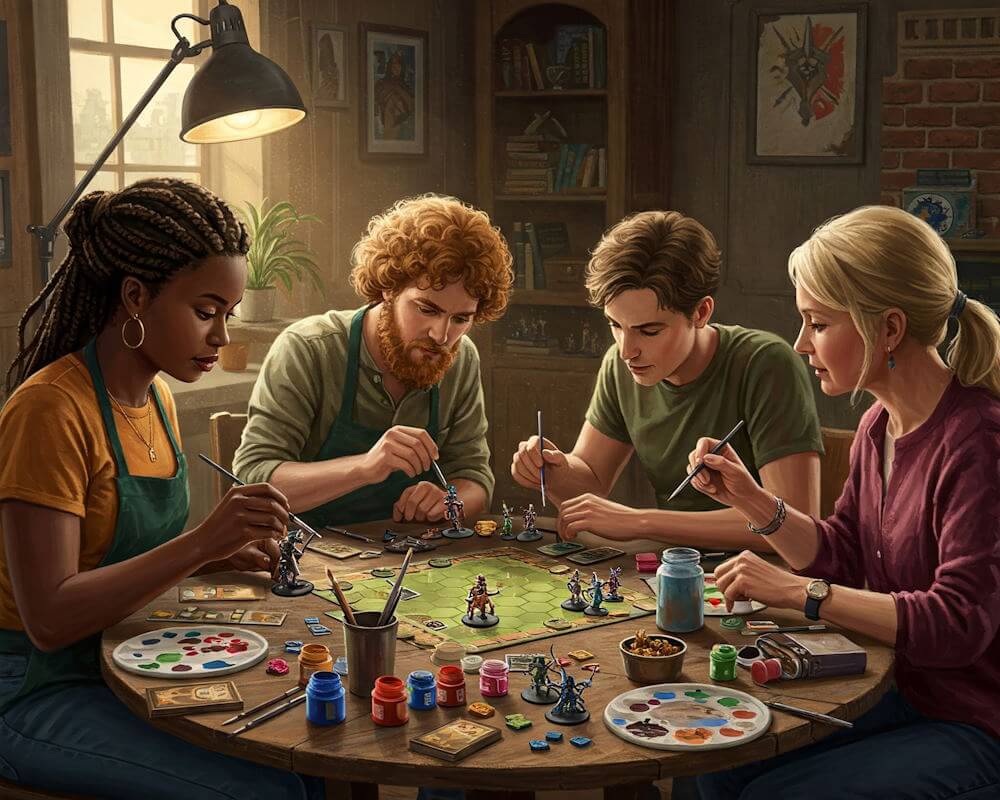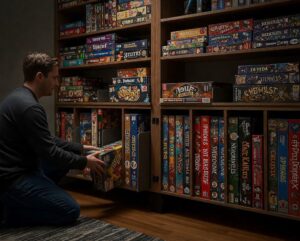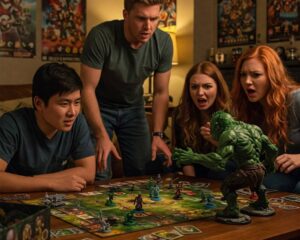Miniature painting has garnered significant popularity among board game enthusiasts, offering an engaging avenue for personal expression. The appeal of painting board game miniatures lies not only in the artistic satisfaction it brings but also in its ability to enhance the overall gaming experience. Customized miniatures allow players to bring their unique vision to life, fostering a deeper connection to the game and its characters. Moreover, individuals can develop their painting skills while enjoying the creative process, leading to personal fulfillment and a sense of accomplishment.
The relevance of miniature painting extends beyond aesthetics; it fundamentally transforms how players interact with the game. A painted miniature not only adds visual appeal but can also contribute to immersion, enriching storytelling aspects by rendering the characters and settings more lifelike. This personalized approach can significantly impact game nights, as players often take pride in showcasing their handiwork, enhancing both the gameplay and enjoyment for all involved. Furthermore, the act of painting can enhance one’s familiarity with the game’s components, fostering improved strategies and teamwork during play.
Before embarking on this artistic journey, it is essential to gather the necessary materials. A variety of paints, brushes, and tools are available to suit different styles and preferences, ranging from beginner kits to advanced supplies. This blog post will explore an array of techniques, providing insights into color selection, brush control, and paint application to achieve various effects. Understanding these elements will empower readers to create captivating miniatures that reflect their personal tastes and enhance their gaming sessions. Whether you are a novice or an experienced artisan, this guide will serve as your roadmap through the captivating world of miniature painting.
Essential Tools and Materials
When embarking on the journey of painting board game miniatures, having the right essential tools and materials at your disposal is vital for achieving satisfactory results. A well-equipped painter’s toolkit typically includes brushes, paints, palettes, sealants, and cleaning supplies, each serving a unique function in the overall process.
Firstly, brushes are one of the most critical tools in your arsenal. They come in various shapes and sizes, with fine detail brushes enabling intricate designs while larger flat brushes are useful for broader strokes. For optimal performance, consider a mix of synthetic and natural hair brushes. Brands such as Winsor & Newton offer a comprehensive range, with options for both budget-conscious hobbyists and those willing to invest in premium brushes.
Next, the choice of paints is paramount. Acrylic paints are popular among miniature painters due to their water-soluble nature and vibrant pigmentation. High-quality brands like Citadel or Vallejo provide extensive color ranges tailored for miniatures. Conversely, if budget constraints exist, consider more affordable options like Apple Barrel or FolkArt, which can be found at craft stores.
A palette is essential for mixing colors effectively and preventing waste. Disposable palettes, such as tracing paper or parchment sheets, are convenient for beginners. Alternatively, a more durable wet palette allows you to keep paints moist for longer periods, making it suitable for those who paint frequently.
Sealants play a crucial role in protecting the finished work. Matte and gloss varnishes help ensure that the paint job withstands wear and tear. Brands like Testors and Army Painter offer reliable varnish options suitable for all budgets.
Finally, adequate cleaning supplies, including water cups, paper towels, and brush soap, are indispensable for maintaining your tools. Regular cleaning ensures that brushes retain their shape and last through numerous painting sessions. By investing in quality supplies, you can greatly enhance both the painting experience and the final results of your board game miniatures.
Preparing Your Miniatures for Painting
Preparation is a crucial step in the process of painting your board game miniatures. Proper preparation not only enhances the final appearance of the miniatures but also ensures that the paint adheres effectively. The first step in preparing your miniatures involves cleaning them thoroughly. Many miniatures come with mold release agents from their manufacturing process, which can hinder paint adherence. To clean them, rinse your miniatures under warm water and use a mild soap solution to remove any oils or residues. A soft brush, such as an old toothbrush, can be effective for scrubbing hard-to-reach areas.
Once cleaned, the next step is to inspect your miniatures for mold lines. Mold lines are the seams left from the manufacturing process and can be unsightly if left unaddressed. These lines should be carefully shaved off using a hobby knife or fine-grit sanding sponge. Taking the time to eliminate these imperfections will significantly improve the overall look of your painted miniatures.
After cleaning and removing mold lines, the miniatures need to be assembled if they consist of multiple parts. Using super glue, ensure that each part is securely attached, maintaining alignment to prevent any gaps when painted. Once fully assembled, it is vital to wash the miniatures again to remove any dust or oils from your fingers that may have been transferred during assembly.
Finally, priming your miniatures is essential before applying paint. The right primer prepares the surface of the miniature, allowing paint to adhere better and enhances color vibrancy. Choose a primer that is suitable for the material of your miniatures—whether plastic, metal, or resin. Apply light, even coats to avoid obscuring fine details. Following these preparation steps will set the foundation for a rewarding painting experience, resulting in miniatures that are not only visually appealing but also durable over time.
Choosing the Right Paints
When embarking on the journey of painting board game miniatures, selecting the appropriate type of paint is crucial for achieving remarkable results. The most popular choices among hobbyists are acrylic paints, oil paints, and other specialized mediums. Each of these options presents unique advantages and challenges, and understanding their characteristics aids in making an informed decision.
Acrylic paints are widely favored due to their quick drying time and ease of use. They are water-based, making for easy cleanup and minimal toxicity, appealing to many painters. Acrylics also offer vibrant colors and a range of finishes, from matte to glossy. Many brands, such as Games Workshop’s Citadel paints and Vallejo, provide a vast array of hues specifically formulated for miniature applications. This versatility allows hobbyists to mix colors seamlessly, creating custom shades that elevate their models.
On the other hand, oil paints offer a different set of benefits, known for their rich pigments and blending capabilities. Although they require longer drying times, which can be seen as a drawback, this allows artists to work on detailed techniques like glazing and wet blending without rushing. Brands like Winsor & Newton produce high-quality oil paints that have been used by seasoned miniature painters. Understanding how to work with oils, however, comes with a steeper learning curve, making them more suited for those with prior experience.
Furthermore, there are specialized paints like enamel and spray paints that can also be used depending on the desired outcome. Each medium interacts differently with surfaces and can affect the final appearance of the painted miniature. Ultimately, the choice of paint will depend not only on personal style and preference but also on the techniques being employed.
In terms of color selection, it is advisable to stick to a limited palette for beginners and gradually expand as one gains confidence. Mixing colors can lead to unique shades; therefore, understanding color theory can greatly enhance the painter’s ability to create visually appealing miniatures. By choosing the right type of paint and colors, hobbyists are well on their way to achieving spectacular results in their miniature painting endeavors.
Basic Painting Techniques
When it comes to painting board game miniatures, mastering fundamental techniques is crucial for achieving high-quality results. The following techniques—base coating, layering, dry brushing, washing, and glazing—constitute the foundation of miniature painting and can significantly enhance the visual appeal of your models.
Starting with base coating, this technique involves applying a solid color all over the miniature to provide an even foundation. Select a color that matches the primary shade of the miniature. Utilize a larger brush for this step to cover more surface area efficiently. Ensure that the paint is not overly diluted; the goal is to establish a strong base without losing the details of the sculpted miniature.
Once the base coat is dry, layering can be introduced. This method involves applying lighter shades of the base color to protruding areas to create depth and dimension. Work gradually, adding thin layers of paint while allowing each layer to dry before applying the next. This gradual buildup will create a smooth transition between shades, enhancing the miniature’s three-dimensional look.
Dry brushing is another essential technique that brings out fine details. After applying a base and layers, dip a relatively dry brush into a lighter paint color, then wipe away excess paint on a cloth. Lightly drag the brush over raised details of the miniature; this will highlight textures such as armor or fabric. The result will be a subtle but noticeable enhancement.
Washing follows, which is crucial for shadowing. A wash is a heavily diluted paint that seeps into the crevices of the miniature, adding depth. Apply the wash liberally and allow it to settle into the recesses, enhancing contrasts effectively. Lastly, glazing can soften transitions between colors and unify the overall look. A transparent layer of glaze can also provide a polished finish to your work.
These foundational techniques, when applied correctly, can greatly improve the aesthetics of your board game miniatures, making the painting process both enjoyable and rewarding.
Advanced Techniques for Experienced Painters
For painters who have developed their skills and seek to elevate their craft, advanced painting techniques can provide remarkable results. Techniques such as airbrushing, freehand painting, and texture applications offer unique opportunities to enhance board game miniatures, resulting in more realistic and visually stunning pieces. Each method requires practice and patience but can dramatically improve the overall look of your models.
Airbrushing is a popular technique that allows for smooth and even application of paint, which is especially effective for gradients and large surface areas. By controlling the airflow and paint volume, painters can achieve subtle shading and effects. It is advisable to experiment with different pressures and distances for optimal results. Additionally, airbrushing can save time when painting multiple miniatures, providing a consistent finish that can be hard to achieve with traditional brush techniques.
Another invaluable technique is freehand painting, which involves painting intricate designs directly onto the miniature without the use of stencils or molds. This method allows for personalization, enabling artists to depict unique symbols, patterns, or details that can significantly enhance the character of a piece. While challenging, mastering freehand techniques can set advanced painters apart from their peers and create truly standout miniatures.
Texture applications, including dry brushing and weathering techniques, are vital for adding depth and realism to board game figures. Dry brushing helps highlight raised surfaces and creates a more intricate appearance, while weathering techniques can simulate damage or age, further enriching the narrative of the miniature.
Finally, advanced shading techniques such as blending and glazing are essential for achieving depth and dimension. Blending involves smoothly transitioning colors, while glazing allows for translucent layers of color, enhancing luminosity and richness. Mastering these shading methods requires careful observation and experimentation but can escalate the quality of your miniatures to professional levels.
As experienced painters embrace these advanced techniques, they will find that the key to improvement lies in practice and a willingness to explore new ideas. Implementing these methods can dramatically elevate any miniature army, making the painting journey exciting and rewarding.
Detailing and Finishing Touches
Detailing your board game miniatures is a crucial step in the painting process that elevates the overall appearance and brings your characters to life. One of the most important aspects of detailing is the technique used to paint the eyes. This small feature can dramatically alter the impression of your miniatures. To achieve realistic eyes, begin by painting the entire eye area with a base color, typically a light tone, followed by a smaller dot of a darker shade to represent the pupil. Precision is key, and utilizing a fine-tipped brush will enhance accuracy.
In addition to eyes, adding markings or insignias can significantly personalize your miniatures. These elements can reflect the character’s background or faction. Achieving crisp lines and clear details is best done with a thin brush and a steady hand. You might also consider using stencils for complex designs or decals for intricate patterns, which can save time and improve the final look. Applying decals requires careful positioning and a little patience; using a soft brush can help ensure you don’t get air bubbles.
Once the detailing is complete, the final touches are essential for both protection and enhancement. Highlights can be applied to raised areas of the miniatures, adding depth and dimension. Utilizing a lighter shade than your base color for highlights will create a striking contrast that draws the eye. Finally, applying a varnish, either matte or gloss based on your preference, not only protects your paint job but also contributes to the overall aesthetic. Varnishing can unify the appearance of the miniature and increase its durability, ensuring that your labor of love remains beautiful for years to come.
Display and Storage Solutions
Once your board game miniatures are beautifully painted, displaying and storing them properly becomes essential to preserve your artistic effort. Effective display methods not only enhance the visual appeal of your miniatures but also safeguard them against potential damage. A wide array of options exists for presenting your treasured models, each catering to different aesthetics and spaces.
One popular solution is the use of display cabinets. Glass-fronted cabinets not only protect miniatures from dust but also provide an unobstructed view of the artwork. These cabinets can range from simple designs to elaborate furniture pieces, often tailored to fit specific themes or styles reflecting the collection they house. Adjustable shelves can accommodate varying heights of miniatures, while built-in LED lighting can highlight specific pieces, bringing your collection to life. Additionally, wall-mounted display cases can be a creative way to save space while showcasing your miniatures as part of your décor.
For tabletop display, stands and bases are an excellent choice. They can be custom-made or purchased to elevate the miniatures off surfaces, emphasizing their detail and providing a professional appearance. Sturdy display stands ensure that models remain stable and in prominent view, inviting admiration from gamers and visitors alike.
When it comes to storage solutions, it is crucial to maintain the condition of miniatures when they are not on display. Specialized storage boxes or cases, often padded and compartmentalized, minimize the risk of damage during transport or storage. These units can prevent paint chipping, breaks, or scratches, ensuring the longevity of your work. Additionally, using anti-static materials can further protect painted surfaces from dust and humidity, maintaining the vibrancy and integrity of your miniatures for years to come.
Conclusion and Encouragement to Share Work
As we conclude this comprehensive guide to painting your board game miniatures, it is imperative to reflect on the core elements covered throughout the discussion. This journey into the world of miniature painting not only enhances the aesthetic appeal of your board games but also serves as a fulfilling creative outlet. Throughout this blog post, we have delved into essential techniques, proper tools, and strategies to unleash your creativity while ensuring an enjoyable experience.
Embarking on your miniature painting adventure calls for patience and dedication. As small and intricate as they may seem, each miniature presents an opportunity to explore your artistic prowess. Whether you are a beginner or a seasoned painter, remember that every stroke of the brush contributes to your growth as an artist. Embracing mistakes as part of the learning curve can help bolster your confidence and enhance your skills over time.
Moreover, we encourage you to share your painted miniatures within the community. Showcase your personal art to inspire and be inspired by fellow enthusiasts. Engaging with others not only validates your work but also offers a platform for exchanging tips and techniques. Social media groups and forums dedicated to miniature painting are excellent places to connect with like-minded individuals. By sharing your progress, you contribute to a vibrant community that appreciates the art of miniature painting.
In conclusion, the journey of painting your board game miniatures is more than creating captivating visuals; it is about enjoying the process, learning, and connecting with others who share your passion. So gather your paints and brushes, and let your creativity flow. Each miniature is a canvas waiting for your unique touch, so embark on this rewarding journey and share your artistry with the world.




